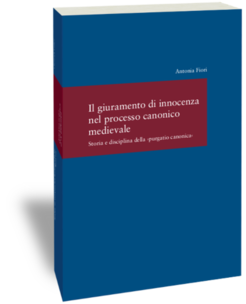Il giuramento di innocenza nel processo canonico medievale.
Storia e disciplina della ›purgatio canonica‹
[The Oath of Innocence in Medieval Canonical Procedure
The History of the purgatio canonica]
Antonia Fiori
Studien zur europäischen Rechtsgeschichte 277
Frankfurt am Main: Klostermann 2013. XIX, 646 p.
ISSN 1610-6040
ISBN 978-3-465-04172-6

The History of the purgatio canonica
Antonia Fiori
Studien zur europäischen Rechtsgeschichte 277
Frankfurt am Main: Klostermann 2013
The oath of innocence, or purgation, was part of canon law for nearly a millennium. It has nevertheless been largely neglected by studies on medieval canonical procedure, since it has generally been considered a Germanic custom “received” by canon law in the early Middle Ages. This book seeks to reconstruct the history of the oath of purgation specifically from the perspective of canon law.
The so-called purgatio canonica changed considerably over the centuries, skillfully adapting itself to changes in canonical procedure. And yet its function never changed: priests were required to swear their innocence when charged with any criminal offence for which evidence of guilt was lacking. They took the oath in order to preserve their good names and reputations before the faithful, and to avoid scandal and infamy. While dealing with canonical purgation the canonists also developed the notion of infamia facti, a concept of social disrepute with real legal significance. Within a short time this inspired the most significant innovations in medieval legal procedure, including the introduction of the inquisitorial process alongside the accusatorial model, the elaboration of a canonical theory of legal presumptions and the justification of judicial torture.
The history of the oath of purgation thus provides a unique perspective to observe the transformations that occurred in canon law procedure and wider legal culture throughout the course of the Middle Ages.
